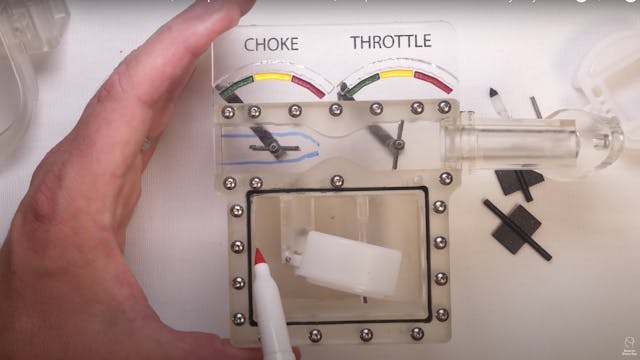See fuel atomization up close with high-speed video of a see-through carb
Smarter Every Day is one of our favorite YouTube channels. Its creator and host, Destin Sandlin, explains the science and physics behind many of the objects and tasks we take for granted every day. One of the first times we remember seeing his channel was the massively popular video in which he tried to ride a bike with backward steering. In the years since, Sandlin’s channel has grown to nearly 10 million subscribers and he’s upped the ante with improved production, adding an impressive high-speed camera to his arsenal.
His latest video reveals the inner workings of a carburetor thanks to a transparent 3D-printed float bowl and venturi as well as some mechanical lessons from his father. For those of us that favor older cars, the science of how a carburetor works may not be a huge revelation, but an entire generation has grown up with EFI, and many that do own carbureted cars may never give the operation a second thought. Even if you come into the video knowing how to rebuild a Holley Dominator while blindfolded, we’re pretty sure you’ll enjoy this video, because there’s some amazing high-speed footage.
As impressive it is to get an engine running on a crude, 3D-printed carb with three moving parts, the beauty of this particular unit, of course, is its see-through design. Sandlin’s unique carb, combined with his high-speed camera, shows the fuel being pulled from the bowl due to Bernoulli’s principle. That high-velocity, low-pressure area causes the fuel to rise into the airstream, where the intake stroke pulls it in and atomizes it.
The fantastic footage shows the fuel atomization, some interesting vortices where the air/fuel mix passes over the throttle plate and tries to navigate the tight corners of the venturi, and something that Sandlin doesn’t mention. Look at the video starting at the 12:40 mark and watch the slow-motion portion. Just after the intake charge moves through the carb, you can see a tiny bit of reversion, as the moving column of air/fuel mixture hits the back of the closed valve and rebounds back a bit. Timed just right, with the proper-length intake tract, that wave of reversion can help increase cylinder filling and volumetric efficiency.
If you liked this video and want to see more Smarter Every Day videos, we suggest you start with the video of the see-though flathead engine from the collaboration with the YouTube channel 805RoadKing. Of course, there are plenty more, since Sandlin has been making videos on the Smarter Every Day channel for more than 13 years!



Hi carbs don’t suck. The piston goes down which causes a low pressure. This low pressure causes the air around it to flow in, this equalise the pressure within the bore to around1 atm all things being equal.(no turbo)
So air is not sucked it’s blown in. It’s like the air is sucked out of the bore as the piston goes down then when the valve opens, then the air is forced in by the high pressure difference between the air outside the bore and the lower pressure inside the bore until the air pressure is equalised.